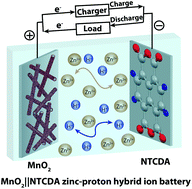Naphthalene dianhydride organic anode for a ‘rocking-chair’ zinc–proton hybrid ion battery†
Abstract
Rechargeable batteries consisting of a Zn metal anode and a suitable cathode coupled with a Zn2+ ion-conducting electrolyte are recently emerging as promising energy storage devices for stationary applications. However, the formation of high surface area Zn (HSAZ) architectures on the metallic Zn anode deteriorates their performance upon prolonged cycling. In this work, we demonstrate the application of 1,4,5,8-naphthalenetetracarboxylic dianhydride (NTCDA), an organic compound, as a replacement for the Zn–metal anode enabling the design of a ‘rocking-chair’ zinc–proton hybrid ion battery. The NTCDA electrode material displays a multi-plateau redox behaviour, delivering a specific discharge capacity of 143 mA h g−1 in the potential window of 1.4 V to 0.3 V vs. Zn|Zn2+. The detailed electrochemical characterization of NTCDA in various electrolytes (an aqueous solution of 1 M ZnOTF, an aqueous solution of 0.01 M H2SO4, and an organic electrolyte of 0.5 M ZnOTF/acetonitrile) reveals that the redox processes leading to charge storage involve a contribution from both H+ and Zn2+. The performance of NTCDA as an anode is further demonstrated by pairing it with a MnO2 cathode, and the resulting MnO2||NTCDA full-cell (zinc–proton hybrid ion battery) delivers a specific discharge capacity of 41 mA h gtotal−1 (normalized with the total mass-loading of both anode and cathode active materials) with an average operating voltage of 0.80 V.



 Please wait while we load your content...
Please wait while we load your content...